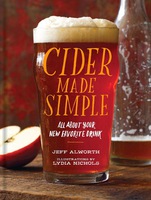Cider Made Simple by Jeff Alworth

Cider has become drastically more popular in the past several years, even in the time since I last reviewed a book about cider. There are now many more good ciders available commercially in my area, and some are even from large producers. Unfortunately, there are even more sugar-wines, apple-flavored lite beers, watered-down ciders, and other alcoholic drinks marketed as cider. This is where Jeff Alworth’s book, Cider Made Simple, comes in.
Cider Made Simple is different from the other cider books I’ve reviewed, it is a “cider-understanding” book, not a cider-making book.1 It is about drinking and enjoying cider, not producing it. Alworth describes traditional cider in a way that is a good antidote to the big commercial ciders and cider-like beverages, covering enough of what goes into producing cider to help distinguish regional varieties, and to become familiar with the terms. The book covers an initial general overview of to cider, then covers the primary cider regions and the characteristics of their ciders. In each of the place-based chapters, Alworth describes the cider of a region intermixed with accounts of visits to cider makers in that region. He also describes the distinctive ways ciders are served in different regions.
Outline:
- Cider Basics: Don’t Call It Hard
- What is cider?
- What are the characteristics of cider?
- Outline of cider styles and related drinks.
- A Is for Apple
- About apples.
- Sweating, Grinding, and Fermenting
- How the fruit affects cider.
- Types of apples from a cider making perspective: sharp, bittersharp, bittersweet, sweet.
- How additional ingredients are used in commercial ciders.
- Proper English Cider
- Traditional English cider and how it devolved into alcopop and how it is recovering.
- Cider Under Cork
- French cider, Calvados, and Pommeau.
- Breaking the Cider
- Spanish ciders.
- The American Cider Renaissance
- The history, disappearance, and revival of American cider.
- Three schools of American cider: traditionalist, modernist, and experimentalist.
- Winter Harvest in Quebec
- Ice cider.
There is also some discussion of what will go in to good new American ciders:
Steve Wood thinks good cider will be defined by fruit. “You gotta start with something that smells good and then you have to keep delivering on the promise. Tannin, fruit, acid, and some kind of balance.” Cider won’t come into its own until we have the fruit to make it special. “Most of the ciders, the so called ‘craft’ ciders, are being made from apples that nobody wants anymore.”
– page 153, the end of American cider chapter
My only quibble with the book is the use of radar charts for “Flavor Wheels” to compare several ciders.
Cider Made Simple is good for someone who knows a bit about beer or wine and wants to learn a little to appreciate cider, and who wants to have an idea what they are getting. It is also good for those who have tried apple-flavored alcopops and want to know about true cider. This is not a complete overview of cider, and isn’t intended to be. But it succeeds in the goal Alworth announced in Cider Digest #1988:
The idea was to make a primer for people new to cider, giving them an overview so they can be armed with useful information when they head down to their local wine store/bottle shop.
This review is one in a series on cider making books.
BibTex reference:
@book{ alworth2015cider,
Author = {Jeff Alworth and Lydia Nichols},
Publisher = {Chronicle Books},
Title = {Cider Made Simple: All About Your New Favorite New Drink},
Year = {2015}
}
-
“cider-understanding” - Dick Dunn in the Cider Digest #2004 talking about this sort of book. ↩